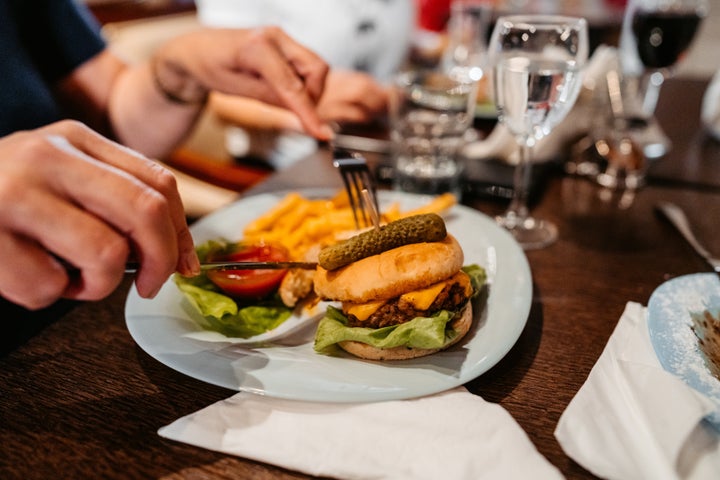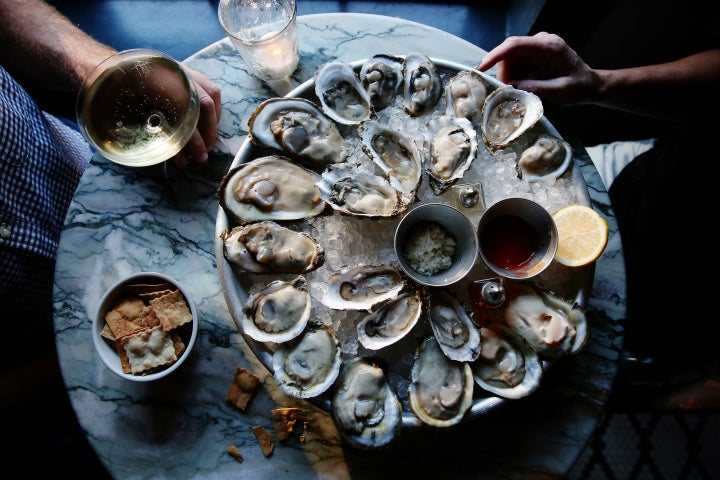
Many diners steer clear of shellfish at restaurants, fueled by a fear of spending the night hunched over the porcelain throne. But are they missing out on the best paella of their lives for no good reason, or are their fears justified?
HuffPost spoke with food safety experts about the foods they avoid when they eat out and why you might also want to.
Steak Tartare
A favourite of fancy French bistros, steak tartare is raw ground steak mixed with shallots, capers, olive oil, mustard and a raw egg on top. If it sounds like a food safety expert’s nightmare, it is.
Home cooks know to cook ground beef to 160 degrees Fahrenheit before eating it to prevent foodborne illness, and there’s a good reason. “Beef is produced in such a way that during the slaughtering process, it’s inevitable that some of the faecal material within the animal’s intestines has touched or spread onto the raw meat,” said Bryan Quoc Le, a food scientist and author of “150 Food Science Questions Answered.”
“Normally, the butchered meat is disinfected with a number of sanitising compounds,” he explained. “But some pathogenic microorganisms found in the intestines of cattle, such as E. coli subvariant O157:H7, are very resistant to these treatments.” According to Le, it takes only a few cells of a pathogen like E. coli to survive to cause a foodborne illness, which is why cooking beef is essential to killing all potential pathogens.
Ensuring that this dish of raw meat doesn’t make everyone sick comes down to trusting the establishment to prepare it safely. Martin Bucknavage, the senior food safety extension associate at Penn State Department of Food Science, explained, “It is not that I dislike it, but it does have a higher risk of contamination from bacterial pathogens such as pathogenic E. coli. One really puts a lot of faith into the restaurant that they have prepared it in a way to eliminate any of these pathogens.”
Raw Sprouts
Often stuffed in sandwiches and wraps to add a crunch or used as a garnish on a beautifully plated entrée, raw sprouts like alfalfa, clover, mung and bean sprouts have been linked to many food poisoning outbreaks.
How come these little leafy veggies cause so much damage? “Sprouts are grown from non-sterile seeds that carry microbial spores or colonies, which are kept in a moist environment at a temperature of 70 to 85 degrees Fahrenheit,” Le told HuffPost.
“As this is well above refrigeration conditions, these temperatures allow microorganisms to grow fairly rapidly. They are sprouted in soil or a porous material such as coconut coir, peat moss or perlite. These are also not sterile materials. A number of pathogens can grow, including salmonella, E. coli and listeria. Because it can take up to three to four days to complete the sprouting process, the cell counts for these microorganisms can reach billions.”
Washing the sprouts doesn’t remove the microorganisms that can cause foodborne illness. Instead, cook sprouts to kill any bacteria, though this diminishes their crisp and fresh texture.

Raw Shellfish, Specifically Oysters
Long associated with aphrodisiac properties for lovers, these shellfish are on the no-no list for food safety experts, especially when consumed raw. “They tend to be scavengers or bottom feeders and can concentrate a high amount of bacteria, viruses and other contaminants,” Le told HuffPost. In 1995, one particular outbreak saw 84 people get sick with the Norwalk virus after consuming raw oysters, and the study cited the likely cause thusly: “This outbreak was caused by contamination of oysters in the oyster bed, probably by stool from one or more ill harvesters.”
Another major issue with shellfish is vibriosis, an illness that comes from Vibrio bacteria. Especially pernicious, this bacteria lives in coastal water and is in its highest concentration during part of the oyster harvesting season. People can become infected with vibriosis by eating raw oysters or shellfish, and it can have serious consequences like requiring amputation of limbs.
Improper handling of raw oysters by restaurant staff, including poor temperature control (not keeping raw shellfish cold enough), can encourage pathogen growth in shellfish. For this reason, Bucknavage focuses more on the establishment than food items. “I look for restaurants that are clean and well run, have good online ratings and good inspection results,” he said. “When there are outbreaks, it is more about failure in proper procedures of the establishment.”